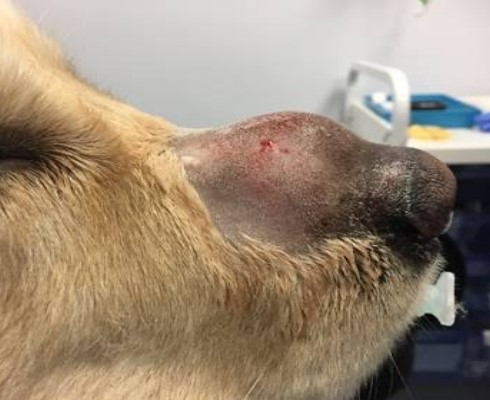
The case report has documented breakthrough treatment possibilities for dogs infected with Mycobacterium avium
Lumbry Park Makes Mycobacterium Avium Breakthrough
A new case report, conducted by the Internal Medicine team at Lumbry Park Veterinary Specialists and supported by the University of Edinburgh, has documented breakthrough treatment possibilities for dogs infected with Mycobacterium avium.
Mycobacterium avium infections in dogs are rare in the UK, although slightly more common in cats. There have been only 49 published cases of M. avium worldwide. However, cases are increasingly being diagnosed in companion animals in the UK.
Once diagnosed with MAC mycobacteriosis*, the prognosis for affected dogs is usually poor; most die or are euthanised. Mycobacterial granulomas are often found in several organs, including the spleen, liver, lung, bone marrow, and assorted lymph nodes[i].
Choosing to treat dogs suffering with M. avium infection is a complex decision due to the requirement for significant treatment commitment, the risk of relapse, zoonotic considerations (particularly with immunocompromised clients), and appropriate antimicrobial stewardship.
The new case report reviewed the long-term outcome, diagnostic imaging follow-up and treatment of two dogs[ii] diagnosed with M. avium infections diagnosed at Lumbry Park. It also compared the findings from their initial diagnoses to those of their relapses.
The findings highlighted that a viable treatment option is available that can lead to clinical remission, in the form of a multi-drug combination antibiotic therapy - including fluoroquinolones, rifampicin, doxycycline, clarithromycin, and a protocol containing ethambutol.
However, they also documented relapses following discontinuation of treatment - indicating the eradication of the organism is unlikely, though relapses resolved when restarting the multidrug combination therapy.
The case report also revealed the potential for patients treated for M. avium infections to achieve long-term survival. Both Lumbry Park cases were clinically well up to 4 years after diagnosis with no evidence of clinical disease but required ongoing therapy.
Victoria Coates, Internal Medicine resident at Lumbry Park who led the study, said: “To our knowledge this report is the first to describe the long-term outcome and diagnostic imaging follow up in two dogs diagnosed with Mycobacterium avium treated with multidrug combination therapy.
Previously published cases included non-favourable outcomes with progression of disease and euthanasia, and lack longer-term diagnostic or treatment information.
“Our findings document a huge step forward in the successful treatment and management of M. avium infections in dogs. And we hope that they could lead to improved chances of survival for patients suffering with this previously fatal disease.
“However, our findings also illustrate the challenges of treatment of canine M. avium - including the need for multi-antibiotic potentially life-long therapy and high risk of relapse - all of which should be considered when approaching management of a case.”
The Long Term Follow Up Of Two Dogs Diagnosed With Mycobacterium Avium, Victoria Coates, Samantha Taylor, Clarisse D’Août, Conor O’Halloran, Cesar Sanchez Jimenez, has been published in the BSAVA's Journal of Small Animal Practice Long-term follow up of two dogs diagnosed with Mycobacterium avium | BSAVA Library.
Lumbry Veterinary Referrals is one of the largest and most advanced veterinary specialist referral centres in the UK. With a 140-strong team, it offers a broad range of specialist veterinary referral services including anaesthesia and analgesia, cardiology, dermatology, diagnostic imaging, internal medicine, neurology and neurosurgery, ophthalmology, oncology, orthopaedics, physiotherapy, soft tissue surgery and has its own Critical and Emergency Care Centre.
For more information about Lumbry Park, which is part of the CVS Group, visit www.lumbrypark.co.uk.
* Mycobacterium avium
The M. avium infection is sub-divided into two clinicopathologically different groups:
- The obligate (disease-causing) pathogens of the Mycobacterium tuberculosis complex cause Tuberculosis in both human and animal species. Here, cases of canine tuberculosis have rarely been documented.
- The pathogens of the non-tuberculous mycobacteria (NTM) result in mycobacteriosis. These ubiquitous pathogens, of which not all can cause disease, are environmental. Although canine infections due to NTM are sporadically reported, the most frequently identified NTM infection in UK companion animals is the M. avium complex (MAC)[iii]. In humans, MAC is reported to be the leading cause of pulmonary and disseminated mycobacteriosis. Comparatively in dogs, the clinical manifestation of MAC is highly variable, depending on several factors including the route of exposure, dose, the infecting Mycobacterium species, and host factors.
i van Ingen et al., 2009; Gelendi et al., 2021; Kim et al., 2022
ii Case 1 is a 3-year-old, male neutered Golden Retriever who initially presented with a progressive nasal swelling and no systemic disease. Case 2 is a 1-year-old, male neutered Portuguese Podengo who presented with immune-mediated polyarthritis secondary to systemic M. avium infection.
iii O’Halloran & Dobromylskyj, 2017; Ghielmetti & Giger, 2020
More from CVS UK Ltd
- New study reveals key prognostic indicators in canine mast cell tumours
- Ernie’s ball trouble: Managing a challenging oesophageal foreign body
- New study reveals need for cultural change and increased safety focus in companion animal veterinary practices
- CVS Group halves the amount of waste going to landfill
- CVS supports innovative PhD to promote responsible prescribing habits in veterinary practice

 9 months ago
9 months ago  708 views
708 views

 4 days ago
4 days ago